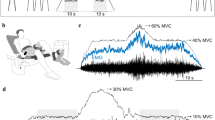Abstract
Frequency (mean and median power frequency, f and f m) and amplitude (average rectified and root mean square values, ARV and rms), parameters of the M-wave, and the dorsiflexor force parameters of the anterior tibial muscles were measured in seven healthy human subjects. Intermittent, voluntary contractions at relative intensities (40%, 60%, and 80%) of maximal voluntary contraction (MVC) were performed in conjunction with electrical stimulation. The M-wave parameter changes were measured over the course of the isometric contractions. At higher force levels, M-wave potentiation was observed as increases in both ARV and rms. The ARV augmentation attained levels as high as 206.1 (SD 7.4)% of resting values after both initial and final contractions of 80% MVC, reaching statistical significance (P < 0.01). The f and f m failed to show a significant difference at any level of contraction. It was surmised that potentiation of the M-wave was the result of an increased contribution of muscle fibre type IIb recruited during higher contraction levels, reflecting the change to larger, deeper innervating motoneurons as the intensity of contraction, as a percentage of MVC, rose. Recruitment of type IIb fibres, which have been reported to have a higher energy potential and frequency content, were thought to reflect changes in the local, excitability threshold of some motor units as the force intensity increased during the intermittent voluntary contractions. It is suggested that the M-wave elicited after contractions has the potential to reflect, to some extent, motor unit recruitment changes resulting from the preceding contractions, and that through comparisons of M-wave amplitude parameters, contributions of varying fibre types over the course of a contraction may be indicated.
Similar content being viewed by others
References
Arendt-Nielsen L, Mills KR, Forster A (1989) Changes in muscle fibre conduction velocity, mean power frequency, and mean EMG voltage during prolonged submaximal contractions. Muscle Nerve 12:493–497
Bellemare F, Garzaniti N (1988) Failure of neuromuscular propogation during maximum voluntary contraction. J Appl Physiol 64:1084–1093
Bigland-Ritchie B, Kukulka GG, Lippolad OGJ, Woods JJ (1982) The absence of neuromuscular transmission failure in sustained maximal voluntary contractions. J Physiol 330:265–278
Bigland-Ritchie B, Furbush F, Woods JJ (1986) Fatigue of intermittent submaximal voluntary contractions: central and peripheral factors. J Appl Physiol 61:421–429
Broman H, Bilotto G, De Luca CJ (1985) Myoelectric signal conduction velocity and spectral parameters: influence of force and timel. J Appl Physiol 8:1428–1437
Brown WF, Kadrie H, Milner-Brown HS (1981) Rank order of recruitment of motor units with graded electrical stimulation of median and ulner nerves in normal subjects and in patients with entrapment neuropathies. In: Resmedt JE (eds) Motor unit types, recruitment and plasticity in health and disease. Karger, Basel, pp 321–330
De Luca CJ (1984) Myoelectric manifestations of localized muscular fatigue in humans. Crit Rev Biomed Eng 11:251–279
DeLuca CJ, Merletti R (1988) Surface myoelectric signal cross-talk among muscles of the leg. Electroencephalogr Clin Neurophysiol 69:568–575
Duchateau J, Hainaut K (1985) Electrical and mechanical failures during sustained and intermittent contractions in humans. J Appl Physiol 58:942–947
Fenton J, Garner S, McComas AJ (1991) Abnormal M-wave responses during exercise in myotonic muscular dystrophy: A Na+/K+ pump defect? Muscle Nerve 14:79–84
Fitch S, McComas AJ (1985) Influence of human muscle length on fatigue. J Physiol 362:205–213
Galea V, McComas AJ (1991) Effects of ischaemia on M-wave potentiation in human biceps brachii muscles. J Physiol 438:212P
Helliwell TR, Coakkley J, Smith PE, Edwards RH (1987) The morphology and morphometry of the normal human tibialis anterior muscle. Neuropathol Appl Neurobiol 13:297–307
Henriksson-Larsen K, Friden J, Whetling M (1985) Distribution of fibre sizes in human skeletal muscle. An enzyme histological study in muscle tibialis anterior. Acta Physiol Scand 123:171–177
Hicks AL, McComas AJ (1989) Increased sodium pumping activity following stimulation of rat soleus muscles. J Physiol 414:337–350
Hicks AL, Fenton J, Garner S, McComas AJ (1989) M wave potentiation during and after muscle activity. J Appl Physiol 66:2606–2610
Knaflitz M, Merletti R (1988) Suppression of stimulation artifacts from myo-electric evoked potential recordings. IEEE Trans Biomed Eng 35:758–763
Knaflitz M, Merletti R, De Luca CJ (1990) Inference of motor unit recruitment order in voluntary and electrically elicited contractions. J Appl Physiol 68:1657–1667
Kuiack S, McComas AJ (1990) Transient hyperpolarization of noncontracting muscle fibres in anaesthetized rats. J Physiol 426:29P
Kuiack S, McComas AJ (1992) Transient hyperpolarization of noncontracting muscle fibres in anaesthetized rats. J Physiol 454:609–618
Linssen WHJP, Stegeman DF, Joosten EMG, Binkhorst RA, Merks MJH, Ter Laak HJ, Notermans SLH (1991) Fatigue in type I fibre predominance: a muscle force and surface EMG study on the relative role of type I and type II muscle fibres. Muscle Nerve 14:829–837
McComas AJ, Galea V, Einhorn RW (1994) Pseudofacilitation: a misleading term. Muscle Nerve 17:599–607
Merlitti R, Knaflitz M, DeLuca CJ (1992) Electrically evoked myoelectric signals. Crit Rev Biomed Eng 19:293–340
Merton PA (1954) Voluntary strength and fatigue. J Physiol 123:553–564
Mills KR (1982) Power spectral analysis of electromyogram and compound muscle action potential during muscle fatigue and recovery. J Physiol 326:401–406
Milner-Brown HS, Miller RG (1986) Muscle membrane excitation and impulse propogation velocity are reduced during fatigue. Muscle Nerve 9:367–374
Milner-Brown HS, Mellenthin M, Miller RG (1986) Quantifying human muscle strength, endurance, and fatigue. Arch Phys Med Rehabil 67:530–535
Stalberg E (1966) Propagation velocity in human muscle fibres in situ. Acta Physiol Scand 70 [Suppl 287]:1–42
Tesch PA, Komi PV, Jacobs I, Karlsson J, Viitasalo JT (1983) Influence of lactate accumulation of EMG frequency spectrum during repeated concentric contractions. Acta Physiol Scand 119:61–67
Thomas CK, Woods JJ, Bigland-Ritchie B (1989) Impulse propagation and muscle activation in long maximal voluntary contractions. J Appl Physiol 67:1835–1842
Yoneda T, Oishi K, Fujikura S, Ishida A (1986) Recruitment threshold force and its changing type of motor units during voluntary contractions at various speeds in man. Brain Res 372:89–94
Author information
Authors and Affiliations
Rights and permissions
About this article
Cite this article
Nagata, A., Christianson, J.C. M-wave modulation at relative levels of maximal voluntary contraction. Europ. J. Appl. Physiol. 71, 77–86 (1995). https://doi.org/10.1007/BF00511236
Accepted:
Issue Date:
DOI: https://doi.org/10.1007/BF00511236




